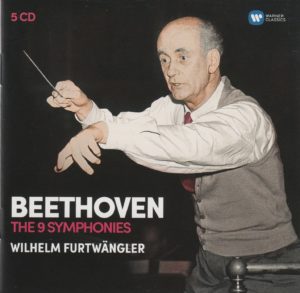 Two years ago (2016-2017), I experienced a musical exploration of Bruckner’s nine primary symphonies from the perspective of some two dozen conductors.
Two years ago (2016-2017), I experienced a musical exploration of Bruckner’s nine primary symphonies from the perspective of some two dozen conductors.
Somewhere along the way (probably when I got to the “F” letter of the alphabet), I discovered Wilhelm Furtwangler (1886-1954).
I was immediately taken with the historic nature of the recordings and wanted to learn more about the legendary German conductor.
As a consequence, I bought the Furtwangler Legacy box set that consists of 107 CDs (plus bonus DVD) that, as far as I know, the set purports to be his complete works. (The CDs to which I’m listening this morning were not taken from the Legacy box, which contains recordings even older than today’s.)

Because of my interest in Furtwangler, I purposely chose to include him in my exploration of Beethoven’s nine symphonies.
So far, the results have been mixed.
 Beethoven wrote his symphonies in four parts (except for the Sixth, which is in five). The time breakdown of this particular one (Symphony No. 2 in D Major), from this particular conductor (Furtwangler, at age 62) and this particular orchestra (Wiener Philharmoniker), at this particular time in history (October 3, 1948) on this particular record label (Warner Classics) is as follows:
Beethoven wrote his symphonies in four parts (except for the Sixth, which is in five). The time breakdown of this particular one (Symphony No. 2 in D Major), from this particular conductor (Furtwangler, at age 62) and this particular orchestra (Wiener Philharmoniker), at this particular time in history (October 3, 1948) on this particular record label (Warner Classics) is as follows:
I. Adagio molto – Allegro con brio………………………………………………………………10:11
II. Larghetto…………………………………………………………………………………………………..11:11
III. Scherezo. Allegro – Trio……………………………………………………………………………4:04
IV. Allegro molto…………………………………………………………………………………………….6:54
Total running time: 32:20
My Rating:
Recording quality: 1 (debilitating tape hiss, pops, scratches, flat, muddy – sounds like it was recorded off an acetate record, rather than made from original master tapes)
Overall musicianship: 3 (hard to say because of the horrendous recording)
CD liner notes: 4 (essays on Furtwangler written in English, German, and French, however historical details missing or hard to find: Where was this recorded? When? What orchestra? That information is in small print on the back of the CD sleeves)
How does this make me feel: 2 (a big, fat “Meh!”)
This is the worst recording of a Classical concert I’ve ever heard. It’s akin to the recordings I have of Enrico Caruso, made between 1902 and 1920.
That’s not to say the Furtwangler performance itself is bad. I refer only to the quality of the sound. But it’s hard to comment on the former because of the quality of the latter.
Unless I miss my guess, this was recorded off a record, rather than mastered from the original tapes. It sounds scratchy and hissy and flat. It’s tremendously distracting.
Still, when I listen through and around the hiss, pop, and scratch, I can hear a powerful, masterful performance. There are glimpses of magic here.
From a historical perspective, the poor recording lends itself to a kind of excitement, a feeling that I’m listening to something very old, and – by virtue of its existence – very important. It’s like of like discovering a long-lost recording of Abe Lincoln’s voice. I know it’s important, even if the quality is genuinely shitty.
I can’t give this anything other than a “Meh!” rating. It’s a recording to which I’ll never listen again.
